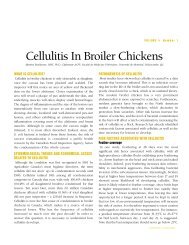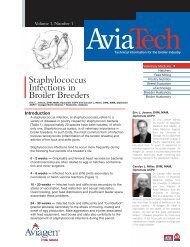Enterococcus Cecorum
Enterococcus Cecorum
Enterococcus Cecorum
Create successful ePaper yourself
Turn your PDF publications into a flip-book with our unique Google optimized e-Paper software.
The Poultry Informed Professional is published by the Department of Population Health of The University of Georgia College of Veterinary Medicine. © 2010 Board of regents of the University Systemof Georgia except for: United States Government Publications: “Livestock, Dairy and Poultry Situation and Outlook” (Economic Research Service, USDA); “Broiler Hatchery” and “Chicken andEggs” (National Agricultural Statistics Service, Agricultural Statistics Board, U.S.D.A.)©. Articles may be reprinted with permission. For information and permission to reprint, contact Ashley Moody,(706) 542-1904Issue 117March/April 2011®Published by the Departmentof Population Health, University of GeorgiaEditor: Dr Stephen Collett, Associate ProfessorCo-Editor: Dr Pedro Villegas, ProfessorDepartment of Population HealthPhone (706) 542-1904 Fax (706) 542-5630e-mail: Ashley Moody at armoody@uga.edu<strong>Enterococcus</strong> cecorum-related arthritis and osteomyelitis in broilers and broilerbreedersNatalie K. Armour, Stephen R. Collett, Susan M. WilliamsUniversity of Georgia, Poultry Diagnostic and Research Center, Athens, GA 30602The isolation of <strong>Enterococcus</strong> cecorum from arthritis and osteomyelitis lesions, and its association with lamenessoutbreaks in broilers and broiler breeders has sparked increased interest in this topic. In this issue, wedescribe recent E. cecorum-related lameness cases in Georgia, review common features of reported cases, anddiscuss how this usually harmless gastrointestinal tract inhabitant can occasionally cause significant disease.Contents<strong>Enterococcus</strong> cecorum-related arthritisand osteomyelitis in broilers and 1-7broiler breedersExcerpts. “Broiler Hatchery”“Chicken and Eggs” and Turkey 8Hatchery...Broiler performance data(Company) Previous month 9Meetings, Seminars and Conventions10BroilerLive Production CostData for week ending March 11th 2011Average CompanyFeed Cost/ton w/o color ($) 312.79Feed cost /lb meat (c) 28.89Days to 4.6 lbs 41Chick cost / lb (c) 5.07Vac-Med cost/lb (c) 0.06WB & ½ parts condemn. Cost/lb 0.22% mortality 4.60Sq.Ft. @ placement 0.82Lbs/sq. ft. 7.35Downtime (days) 15Page 1
<strong>Enterococcus</strong> cecorum is a normally innocuous inhabitant of the gastro-intestinal tract of various mammalsand birds (Devriese et al., 1991, 1992a, 1992b, 1994; Baele et al., 2002). It was not until 2002 that thisorganism was associated with clinical disease in poultry, when it was isolated from osteomyelitis lesions followingoutbreaks of lameness in broilers in Scotland (Wood et al., 2002) and in the Netherlands (Devriese et al.,2002). More recently, a succession of similar outbreaks of E. cecorum arthritis and osteomyelitis have occurredin broilers and broiler breeders in the United States (Aziz and Barnes, 2007), Belgium (De Herdt et al., 2008),Canada (Stalker et al., 2010) and Hungary (Makrai et al, 2011). E. cecorum related disease can cause significanteconomic loss, due to mortality (predominantly as a result of culling), poor feed conversion and increased condemnationsat processing. Recurrent outbreaks of lameness in affected houses with subsequent flocks haveexacerbated the impact of this disease (De Herdt et al., 2008; Gingerich, 2009). Recently, several cases of E.cecorum-related arthritis and osteomyelitis were diagnosed in broilers and broiler breeders in the state of Georgia.Case ReportsHistory and clinical signs: The outbreaks of lameness involved one broiler farm and five broiler breederfarms in Georgia. Affected birds displayed a variety of clinical signs, including swollen, inflamed hocks, “hocksitting”(a characteristic posture involving resting on the hocks, with back arched and legs raised slightly offthe ground and extended forward) and paresis to complete posterior paralysis. Mortality (including culls) attributedto lameness was estimated to be 5-7% during rearing, and was non-responsive to in-feed chlortetracyclinemedication. The broiler flock was 48 days of age at the time of submission, while breeder flocks rangedfrom 3.5 to 18.5 weeks of age. Males were predominantly affected.Figure 1. A 49 day old male broiler breederdisplaying a characteristic posture associatedwith compression of the spinal cordPage 2
Necropsy findings: Vertebral lesions were a feature of the breeder cases, and involved osteomyelitis of thecaudal thoracic vertebra immediately cranial to the kidneys (T6, with occasional involvement of adjacent vertebrae),with impingement on the spinal cord, and dorsal collapse of the vertebral column in some cases. Theaffected bone had lost its normal architecture, and was typically friable and pale yellow, with caseous exudatesin some cases. Advanced vertebral osteomyelitis lesions correlated well with the “hock-sitting” postureand posterior paresis / paralysis. A significant percentage of lame birds had femoral osteomyelitis and septicarthritis of the hock joints; sometimes in the absence of vertebral lesions. In addition to the skeletal lesions,there was evidence of respiratory disease (conjunctivitis, tracheitis and airsacculitis) in the broiler flock and inthe 3.5 week old breeder flock. These breeders had moderate to severe bursal atrophy, which was confirmedmicroscopically.Figure 2. Vertebral osteomyelitis, with dorsalcollapse of the vertebral column and spinalcord compressionDiagnostic testing: E. cecorum was isolated in pure culture from affected hock joints and from femur andvertebral osteomyelitis lesions. The isolates were initially identified as suspect <strong>Enterococcus</strong> sp. based on theircultural characteristics, Gram stain morphology and negative catalase reaction. The API20STREP® identificationsystem (bioMérieux Inc., Durham, NC) consistently identified the isolates as Streptococcus bovis. However,the reaction profiles corresponded with those previously described for <strong>Enterococcus</strong> cecorum (Devriese etal., 2002), and subsequent analysis of cultures with the bioMérieux Vitek 2 Compact bacterial identificationsystem confirmed that the isolates were indeed E. cecorum. Microscopic examination of the vertebral lesionsrevealed osteomyelitis and granuloma formation, with characteristic intralesional cocco-bacilli. Lesions weretypically associated with narrowing of the vertebral canal and necrosis of the spinal cord white matter. Affectedbirds were serologically negative for MG and MS, and no respiratory viruses were isolated from trachea,lung and kidney samples.Page 3
Figure 3. Granulomatous inflammation:necrotic bone with bacteria surroundedby multinucleated giant cellsand heterophilsFigure 4. Pure culture of E. cecorum onblood agar, demonstrating alpha hemolysis(greening of the agar surroundingthe colonies)Figure 5. Gram stain of a pure culture of E.cecorum, showing characteristic Gram positivecocco-bacilliPage 4
Discussion:While the pathogenesis of E. cecorum related osteomyelitis is not well understood, common features inepidemiology and clinical presentation have led to several authors to suggest mechanisms by which this“normal” GIT inhabitant exerts its pathogenic effects.Location of the lesion: Vertebral osteomyelitis in poultry frequently involves the 5 th to the 7 th thoracic vertebra.The second to the fifth thoracic vertebra are fused, and the seventh thoracic vertebra is fused to thelumbar and sacral vertebra (Wise, 1975). Since the sixth thoracic vertebra is “free”, it is subject to increasedmechanical stress, and it is conceivable that microtrauma, with consequent inflammation and hemorrhage,could create a sequestration site for <strong>Enterococcus</strong> cecorum.Sex of the bird: Weight bearing stress is greatest in heavy breeder males, and would explain why the malebroiler breeders are predominantly affected. This finding is consistent with previous reports of the disease affectingpredominantly male chickens (Aziz and Barnes, 2007; De Herdt et al., 2008; Gingerich, 2009; Stalker etal., 2010; Makrai et al., 2011).Bird age: The age of onset of clinical signs caused by to E. cecorum osteomyelitis varies. In broilers, the diseasehas been reported in birds as young as 7 to 14 days of age (De Herdt et al., 2008), but it appears to manifestlater in broiler breeders, with reports of disease between 6 and 10 weeks of age (Aziz and Barnes, 2007).This could be a function of growth rate, which is significantly higher in broilers than in breeders. In the Georgiacases described here, the broilers were 48 days of age, while the broiler breeders ranged from 3.5 to 18.5weeks of age.Respiratory, intestinal and epithelial damage: E. cecorum is a normal component of the gastrointestinalflora of chickens. Disturbance of the normal gut microbial balance could conceivably cause a relative increasein E. cecorum numbers in the GIT, and thus in the poultry house environment. Invasion into systemic circulationmay occur as a result of damage to the respiratory, intestinal or integumentary barriers. Peak prevalenceof lameness cases in Georgia coincided with a particularly cold and wet winter. On several farms where ventilationwas compromised, wet litter and increased ammonia levels resulted. In addition to precipitating respiratorydisease and causing footpad dermatitis, these conditions create a favorable environment for the survivaland sporulation of coccidian oocysts, thus potentially creating multiple opportunities for E. cecorum to invadesystemically. In the field situation, it may be difficult to determine the initial insult that precipitated the outbreakof E. cecorum related lameness, because of the time taken for lesions severe enough to cause clinical signsto develop.Immunosuppressive diseases: In the 3.5 week old breeder chickens described here, there was evidence ofbursal damage, probably as a result of infectious bursal disease (IBD) virus infection. Consequent immuno-Page 5
suppression would impair the ability of the immune system to respond to bacterial infection.Virulence potential: Differences in virulence potential of clinical E. cecorum isolates in comparison with“normal” gastrointestinal isolates have been suggested (De Herdt et al., 2008; Stalker et al., 2010), althoughthis has not been proven.Prevention and treatment: Despite the lack of clarity on pathogenesis and predisposing causes of E. cecorumrelated disease in poultry, there are several management interventions which have shown effect in reducingthe incidence of E. cecorum lameness cases in subsequent flocks. Complete clean-out and disinfection with fumigationof the house, litter replacement (with litter composting in subsequent grow-outs), water line cleaningand continuous water sanitation were reported to reduce the incidence of disease (Gingerich, 2009). Preventativetreatment with amoxicillin and/or tylosin at regular intervals stopped the pattern of recurrent disease inBelgian broiler flocks (De Herdt et al., 2008).Disease prevalence: The lack of reports of E. cecorum related disease in poultry prior to 2002, compared withthe increasing number of outbreaks reported recently have led several authors to suggest that this is an“emerging disease”. Theories on the possible role of increasing virulence of E. cecorum isolates, the increasedprevalence of concurrent infections, genetic selection and changing nutritional requirements, as well as theeffect of restrictions on the use of feed additives have been proposed to explain the apparent increased prevalenceof the disease (De Herdt et al., 2008). Improved diagnostic techniques and equipment have also likelycontributed to increased isolation and detection of E. cecorum, which has rather fastidious cultural requirements,and which may not be correctly identified using standard rapid identification systems. It is also possiblethat thorough investigation of lameness cases, incorporating sectioning of the vertebral column and samplingof osteomyelitis lesions for bacterial culture will reveal a higher-than-expected prevalence of this disease,even in flocks which are not experiencing lameness outbreaks.Differential diagnosis: Vertebral osteomyelitis should be differentiated from other causes of spinal cordcompression, notably spondylolisthesis (“kinky back”; caused by the sub-luxation of adjacent vertebral bodiesin a transverse plane) and scoliosis (lateral deviation of the spinal vertebrae) (Thorp, 1994), which are similarto vertebral osteomyelitis in their clinical presentation.More research is needed to understand the epidemiology and pathogenesis of E. cecorum related osteomyelitisin broiler and breeder flocks, to enable strategic prevention and control of this potentially significantdisease.Page 6
Excerpts from the latest USDA National Agricultural Statistics Service(NASS) “Broiler Hatchery,” “Chicken and Eggs” and “Turkey Hatchery”Report and Economic Research Service (ERS) “Livestock, Dairy and PoultrySituation Outlook”Chickens and EggsReleased March 22, 2011, by NASS, Agricultural Statistics Board, USDAFebruary Egg Production Up 1 PercentU.S. egg production totaled 7.01 billion during February2011, up 1 percent from last year. Production included 6.03billion table eggs, and 974 million hatching eggs, of which908 million were broiler-type and 66 million were egg-type.The total number of layers during February 2011 averaged339 million, down slightly from last year. February eggproduction per 100 layers was 2,065 eggs, up 1 percent fromFebruary 2010.All layers in the U.S. on March 1, 2011, totaled 339 million,down 1 percent from last year. The 339 million layers consistedof 282 million layers producing table or market typeeggs, 54.1 million layers producing broiler-type hatchingeggs, and 3.02 million layers producing egg-type hatchingeggs. Rate of lay per day on March 1, 2011, averaged 73.9eggs per 100 layers, up 1 percent from March 1, 2010.Egg-Type Chicks Hatched Down 7 PercentEgg-type chicks hatched during February 2011 totaled 37.3million, down 7 percent from February 2010. Eggs in incubatorstotaled 40.0 million on March 1, 2011, up 3 percentfrom a year ago. Domestic placements of egg-type pulletchicks for future hatchery supply flocks by leading breederstotaled 264 thousand during February 2011, down 11 percentfrom February 2010.Broiler-Type Chicks Hatched Up 1 PercentBroiler-type chicks hatched during February 2011 totaled709 million, up 1 percent from February 2010. Eggs inincubators totaled 642 million on March 1, 2011, downslightly from a year earlier. Leading breeders placed 7.11million broiler-type pullet chicks for future domestic hatcherysupply flocks during February 2011, up 2 percent fromFebruary 2010.Broiler HatcheryReleased March 23, 2011, by NASS, Agricultural Statistics Board, USDAthe corresponding week a year earlier. Average hatchabilityfor chicks hatched during the week was 84 percent. Averagehatchability is calculated by dividing chicks hatchedduring the week by eggs set three weeks earlier.Broiler Chicks Placed Up SlightlyBroiler growers in the 19-State weekly program placed 170million chicks for meat production during the week endingMarch 19, 2011. Placements were up slightly from the comparableweek a year earlier. Cumulative placements fromJanuary 2, 2011 through March 19, 2011 were 1.85 billion,up 1 percent from the same period a year earlier.Turkey HatcheryReleased March 15, 2011, by the NASS, Agricultural Statistics Board, USDAEggs in Incubators on March 1 Up 4 Percent from Last YearTurkey eggs in incubators on March 1, 2011, in the UnitedStates totaled 27.9 million, up 4 percent from March 1,2010. Eggs in incubators were down 2 percent from theFebruary 1, 2011 total of 28.4 million eggs. Please notethat regional estimates have been discontinued: NASSwill no longer publish regional Turkey Hatchery estimates.Only estimates at the United States level will be publisheddue to the limited number of hatcheries involved.Poults Hatched During February Up 8 Percent from Last YearTurkey poults hatched during February 2011, in the UnitedStates totaled 23.1 million, up 8 percent from February2010. Poults hatched were down 4 percent from the January2011 total of 24.0 million poults.Net Poults Placed During February Up 6 Percent from Last YearThe 22.3 million net poults placed during February 2011 inthe United States were up 6 percent from the number placedduring the same month a year earlier. Net placements weredown 1 percent from the January 2011 total of 22.6 million.Broiler-Type Eggs Set In 19 Selected States Up 1 PercentCommercial hatcheries in the 19-State weekly program set208 million eggs in incubators during the week endingMarch 19, 2011. This was up 1 percent from the eggs setPage 8
Broiler Performance DataLive Production CostCurrent Month ChartsRegionSW Midwest Southeast Mid-Atlantic S-CentralPrevious Month ChartsAverageCompanyFeed Cost/ton w/o color ($) 316.90 320.91 384.51 302.88 316.55 312.79Feed cost /lb meat (c) 30.25 29.31 26.21 28.19 29.50 28.89Days to 4.6 lbs 40 41 41 42 40 41Chick cost / lb (c) 4.63 5.28 5.11 4.90 4.97 5.07Vac-Med cost/lb (c) 0.07 0.08 0.03 0.08 0.02 0.06WB & ½ parts condemn. Cost/lb 0.28 0.18 0.24 0.20 0.18 0.22% mortality 4.97 4.74 5.25 4.73 4.27 4.60Sq.Ft. @ placement 0.88 0.83 0.80 0.78 0.82 0.82Lbs/sq. ft. 7.53 6.96 7.31 7.70 7.65 7.35Downtime (days) 18 14 14 14 15 15Broiler Whole BirdRegionAverageCondemnationSW Midwest Southeast Mid-Atlantic S-Central Company% Septox 0.142 0.098 0.243 0.143 0.072 0.128% Airsac 0.138 0.045 0.091 0.070 0.050 0.079% I.P. 0.059 0.008 0.017 0.010 0.022 0.028% Leukosis 0.031 0.000 0.000 0.000 0.001 0.008% Bruises 0.002 0.005 0.001 0.001 0.001 0.002% Other 0.010 0.014 0.003 0.008 0.010 0.011% Total 0.382 0.171 0.355 0.233 0.156 0.255% ½ parts condemns 0.268 0.243 0.284 0.231 0.306 0.269Data for week ending March 11th 2011Broiler Performance DataLive Production CostRegionSW Midwest Southeast Mid-Atlantic S-CentralAverageCompanyFeed Cost/ton w/o color ($) 314.74 279.99 296.87 312.86 308.86 306.63Feed cost /lb meat (c) 28.69 25.96 27.97 29.98 28.86 28.46Days to 4.6 lbs 41 40 42 40 40 41Chick cost / lb (c) 5.18 4.78 4.59 4.65 4.75 4.90Vac-Med cost/lb (c) 0.08 0.04 0.08 0.07 0.02 0.06WB & ½ parts condemn. Cost/lb 0.19 0.24 0.21 0.27 0.19 0.23% mortality 4.91 4.64 4.88 4.62 4.42 4.71Sq.Ft. @ placement 0.83 0.80 0.78 0.89 0.82 0.82Lbs/sq. ft. 6.96 7.45 7.84 7.49 7.66 7.38Downtime (days) 14 14 14 19 17 16Broiler Whole BirdRegionAverageCondemnationSW Midwest Southeast Mid-Atlantic S-Central Company% Septox 0.106 0.235 0.158 0.146 0.093 0.140% Airsac 0.060 0.088 0.065 0.119 0.048 0.080% I.P. 0.009 0.008 0.015 0.056 0.027 0.028% Leukosis 0.001 0.001 0.000 0.006 0.000 0.002% Bruises 0.006 0.001 0.002 0.002 0.002 0.003% Other 0.016 0.006 0.0011 0.012 0.009 0.011% Total 0.197 0.339 0.252 0.341 0.179 0.264% ½ parts condemns 0.247 0.299 0.243 0.295 0.307 0.287Data for week ending Feb. 25th 2011Page 9Page 9


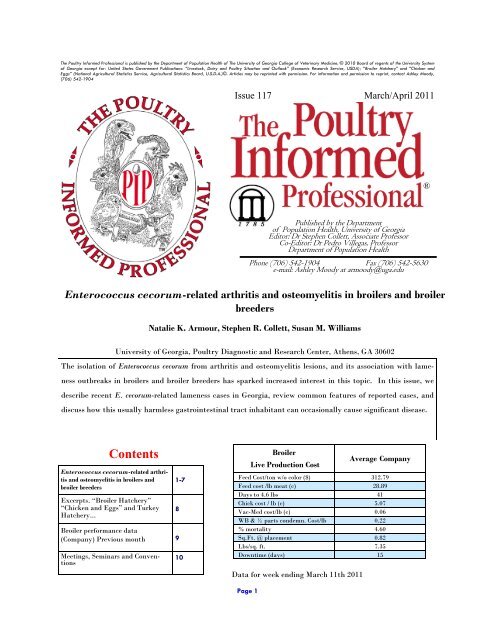
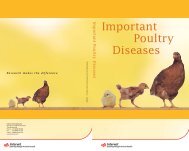
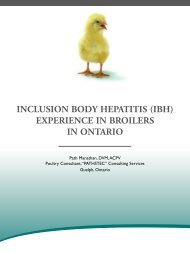
![Avian Immune System - Merial Article [PDF File]](https://img.yumpu.com/34225671/1/190x245/avian-immune-system-merial-article-pdf-file.jpg?quality=85)
